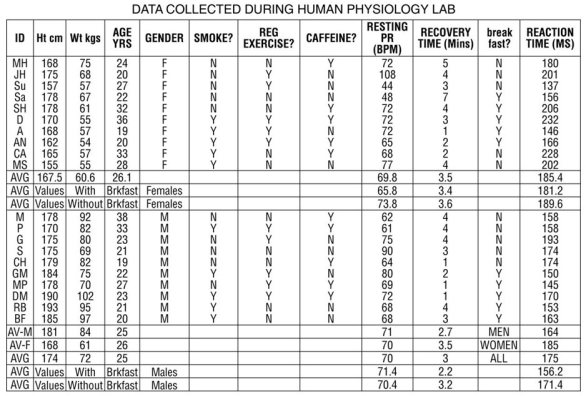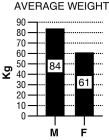Following is a table of data collected from one section of an 8 a.m.physiology lab.There were 20 students present,10 men and 10 women.Information collected from the students included their height,weight,age,and resting pulse rate.In addition,the students were surveyed to see if they smoked cigarettes,considered themselves "regular exercisers," if they had consumed caffeine the morning of the lab,and if they had eaten breakfast that day.A "y" or "n" (yes or no)was recorded to indicate their answers.Each student did "jumping jacks" for 5 minutes and recorded the time required to regain their resting heart rate,which is listed on the table as "recovery time." Finally,each student participated in an exercise designed to measure their reaction time (in milliseconds)in catching an object dropped by a lab partner according to specified criteria.Use this table to answer the following questions.Ignore statistical problems caused by small sample size,and so on.  Table 1.3
Table 1.3  For these questions,the data were separated and analyzed by gender.
For these questions,the data were separated and analyzed by gender.
-Refer to Table 1.3 and the bar graph.
A.Write a hypothesis regarding gender and weight.
B.What is the dependent variable? What is the independent variable?
C.Based on the data in the graph above,what is your conclusion?
D.Why is a bar graph a good choice for presentation of these data? Would another type of chart be as effective?
Definitions:
Sacred
Considered holy or deserving veneration, often associated with divinity, religious practices, or objects imbued with spiritual significance.
Profane
Anything regarded as not sacred or religious; everyday, mundane objects or activities without spiritual significance.
Indigenous Peoples
Indigenous peoples are ethnic groups who are the original inhabitants of a given region, possessing distinct cultures, languages, and traditions, often connected to the land of their ancestors.
Organic Solidarity
The type of social bonds present in modern societies, based on difference, interdependence, and individual rights.
Q2: Which of the following sets of information
Q7: When an audit team does not receive
Q7: their loss is characteristic of cancer<br>A)gap junction<br>B)tight
Q7: Interactions between different globular or fibrous polypeptide
Q27: For each of the tests of controls
Q42: Electrons travel around the center of the
Q52: Auditors use brainstorming<br>A) to heighten the audit
Q68: An auditor is concerned about a policy
Q70: Cancer is not one disease but a
Q125: Isotopes of the same element differ by